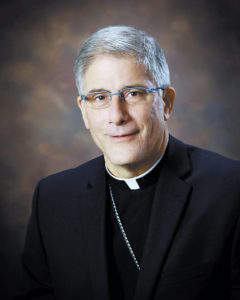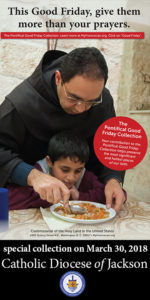
Bishop Joseph Kopacz
By Bishop Joseph Kopacz
For pilgrims who visit the Holy Land, at whatever point on the compass the pilgrimage begins, the goal and culminating experience are the arrival in Jerusalem. This is precisely the path of salvation that the Gospel writers, Matthew, Mark, Luke and John describe in their narratives of the Lord Jesus’ life, death and resurrection. His public ministry unfolded in Galilee and flowed southward like the Jordan River in the direction of Jerusalem.
We followed this Gospel corridor on the recent pilgrimage sponsored by the Knights and Dames of the Holy Sepulcher. At first, we settled in at the Sea of Tiberius in northern Israel, the location of Nazareth, Capernaum, Cana, the Sermon on the Mount and the Transfiguration, before turning southward toward Jerusalem. Although the region is wracked by hatred, violence and periodic outbreaks of deadly hostilities, a consistent reality is that pilgrims are always welcome. Obviously, this is the pragmatic thing to do, but this is also a sign of the abiding respect and good will that many in Israel and Palestine, Jews and Muslims alike, have for the ancient Christian Churches.
Without a doubt, for the Christians who tragically are diminishing in number across the Jerusalem Patriarchate, the mother Church of all Christianity encompassing Israel, Palestine and Jordan, the presence of the pilgrims is critical for their survival. “The pilgrimages are a form of sustenance for the survival of thousands of families.” (Leonardo Cardinal Sandri: Congregation of the Oriental Churches: Good Friday Appeal Letter) I do not know the total annual financial impact of the pilgrims who come from across the globe, but it is substantial. However, we can quantify the money that is collected each year from the Good Friday Holy Land collection.
Last year Catholics throughout the United States, including the Diocese of Jackson that raised ore than $32,000, contributed more than $20,000,000 to the mission and ministries of the Latin Patriarchate of Jerusalem. From this largesse the faithful of the Holy Land were able to renovate and restore the Churches of the Holy Sepulcher in Jerusalem and the Church of the Nativity in Bethlehem.
Recently, a conflict erupted when the Jewish Jerusalem Municipality, with an impending vote in the Knesset, was about to encode in law oppressive taxation upon the Christian Churches with the possibility of foreclosure and seizure of properties if assessments were not paid. The Christian traditions who oversee the Church of the Holy Sepulcher, Orthodox, Armenian, Catholic, responded with the temporary closure of this holiest of sites of the Lord’s crucifixion and burial. (Their statementis posted on www.mississippicatholic.com with this column.)
This sparked an international response and the Knesset canceled the vote, at least for now. Naturally, Christians would not and should not embark on a Crusade in the classic sense, but spiritual and economic muscle do matter. The generosity, prayers and attention of many Catholics and other Christians on Good Friday and throughout the year make a difference. Why should we be concerned? “The Christian faith had the first impulse from the mother Church in Jerusalem which has a special vocation to live the faith in a multi-religious, political, social and cultural context, nothing less than keeping the memory of our Redemption alive.” (Cardinal Sandri)
Of course, it is not only a matter of preserving the ancient sites, but also of fostering the universal mission of our crucified and risen Lord through the modern day ministries of the Churches fighting to survive and thrive. Cardinal Sandri writes: “Notwithstanding the challenges and insecurities, the parishes continue their pastoral services with a preferential attention for the poor. We hope against hope, that the schools serve as a place of encounter between the Christians and the Muslims, where they prepare a future of mutual respect and collaboration, the hospitals and clinics, the hospices and meeting centers continue to welcome the suffering and those in need, refugees and displaced, persons of all ages and religions, struck by the horror of war. A great number of them schooling-age, who appeal to our generosity to resume their scholastic life and dream of a better future.” In his letter Cardinal Sandri elaborates upon the plight of many Christians throughout the region. “Our attention goes to the small Christian community in the Middle East, which continues to sustain the faith among the displaced persons from Iraq and Syria and among the refugees in Jordan and Lebanon. The Pope’s World Day of Peace was directed to the refugee crisis. ‘In a spirit of compassion let us embrace all those fleeing from war and from hunger, or forced by discrimination, persecution, poverty and environmental degradation to leave their homeland.’ Most Iraqi Christians and Syrians want to return to their own land where their houses were destroyed, with schools, hospitals and churches devastated. Let us not leave them alone.”
We know that the Lenten journey is not a solitary act, but an itinerary of solidarity by which each one of us is called to pause, and like the Good Samaritan, accompany our brethren who for many reasons find it difficult to stand up and continue their journey. This is clearly the reality in the Holy Land and throughout the Middle East and we pray that the Good Friday collection will raise up our Christian sisters and brothers.
We are blessed to be able to make a pilgrimage to the Holy Land, once in a lifetime perhaps, but once a year during Holy Week we can make a spiritual pilgrimage through prayer and generosity to be in solidarity with many undergoing persecution and hardship. Please be generous.

Churches in Jerusalem close the Holy Sepulcher in protest
https://ofm.org/blog/churches-jerusalem-close-holy-sepulcher-protest/
